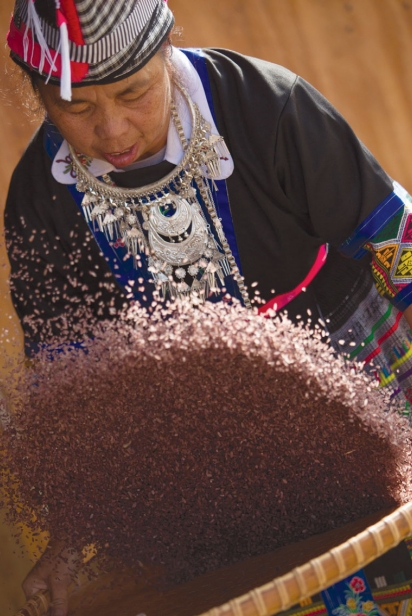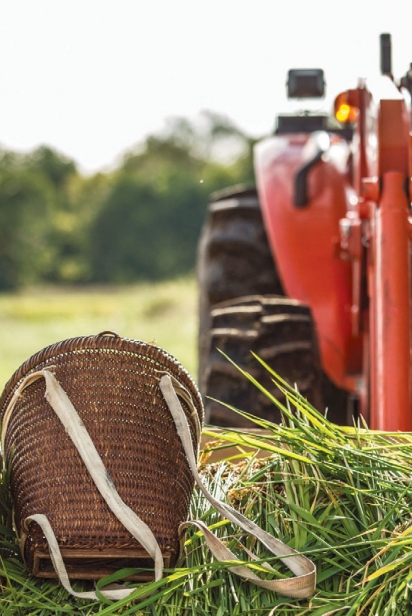Old Ways in a New Land
Oklahoma rice paddy offers Hmong family a taste of home
“They said Oklahoma can’t grow. I said, ‘Yes, Oklahoma can grow!’”
Standing in a rice paddy with Sheng Yang and her family, it’s easy to forget that we’re in northeastern Oklahoma, just outside the rural town of Afton. With water up to our ankles and rice stalks brushing our shoulders, it feels like we’ve been transported to another place, another time even.
Yang grabs a handful of stalks and uses a handheld scythe, or liag, to cut the stalks below the heads then tosses the bundle into a pile nearby. She is dressed colorfully, in traditional Hmong garb: delicately embroidered and wax printed fabrics, a sash around her waist, silver jewelry at her neck and a hat trimmed in neon-pink fringe. On her back she carries a wicker basket.
“In my country, ladies wear this everyday,” Yang says of the elaborate ensemble, which she now dons only for special occasions. “This country is very simple for us.”
Yang’s country, Laos, is peopled with farmers such as herself. She recalls farming in her youth: harvesting by hand, hauling produce in her basket and taking crops to market either by foot or horse.
“You know, my country is not flat. You’d have to go from here to Vinita,” she says, motioning southwest towards a town 20 miles away.
Yang consistently refers to Laos as her country though she left her homeland for Rhode Island at 16 and has yet to return for so much as a visit. The Hmong, an ethnic group that can be traced back millennia to Central Siberia, had lived peaceably in the mountains of Laos since the early 1800s. Warfare in the early part of the 20th century brought turmoil to Indochina and though treaties mandated that Laos remain a neutral country, the communist North Vietnamese did not adhere to those treaties. According to the Hmong American Association of Oklahoma:
“As communist forces and supplies flowed freely along the Ho Chi Minh Trail, it was apparent that America needed an ally. The CIA was instructed to recruit and train an indigenous army in Laos. The Hmong became that army. The Hmong were entrusted to accomplish three main tasks: 1) fight communist regular forces in the northern Laos with an irregular militia; 2) cut the Vietcong supply lines along the Ho Chi Minh Trail; and 3) rescue any downed American pilots shot down over Laos.”
In 1975, as the Vietnam War ended and American forces withdrew from the region, the Hmong faced persecution in Laos for their loyalty to America. As many as 200,000 fled to Thailand as refugees, though untold numbers lost their lives in the treacherous crossing of the Mekong River. As a show of gratitude for their assistance during the war, the U.S. invited Hmong refugees to immigrate to the United States. Resettlement agencies attempted to disperse the immigrants throughout the country, to cities including Tulsa, Kansas City and Des Moines. Sheng Yang and her family started their new lives in Rhode Island.
“We were single then, all of us!” remembers Yang, now the grandmother of nine, gesturing to everyone gathered in the rice paddy. It was in Rhode Island that she met her husband, Choua. His family had settled in the Tulsa area and sent word that there were good jobs here, working in chicken houses. Ten years ago, Yang followed her husband to Oklahoma, while her own family moved farther west to California, where they now work.
“Mostly, the [Hmong] people that come to this country, they work,” Yang says. Her own children hold jobs with hospitals and companies, though they help with the farm. She feels it’s important for them to know how to grow their own food. What if they lose their company jobs, she worries. How would they eat if they didn’t know how to farm?
Choua found work as a machinist once they moved to Tulsa and Sheng was able to return to what she knew best: farming. She applied her agricultural skills, honed in the hills of Laos, to her new land, and with great success. When she first brought her produce to local farmers’ markets, however, she encountered surprising skepticism. Locals were not convinced that her produce, abundant in size and quantity, could have been grown the local, time-honored, family-farmer way. What the local community failed to recognize, initially, was that for Sheng Yang, local, family-farming was first nature. In Laos, where agriculture accounts for over half the nation’s gross domestic product, modern tools of the trade such as tractors, commercial fertilizer and pesticides were simply not available to farmers such as Yang. While many young American farmers were struggling to revive the lost art of small-scale farming, immigrant farmers such as Yang needed only to pick up where they had left off in Laos.
Today, Sheng Yang and her produce are familiar staples at local markets. Market regulars may not know, however, that Yang’s family keeps a secret garden: a three-acre rice paddy, where they grow farm-to-table rice—not for market, but for family.
Prior to visiting the Yang’s farm, my ideas about rice farming were drawn primarily from a single photograph hanging above the bar at Keo, the Asian-fusion restaurant on Brookside. In the photograph, neat bundles of grass rest against a heavy vintage bicycle, a rice paddy sprawling in the background. A major disconnect existed, however, between the lush, grassy, foreign rice paddy of the photo and the actual grains of rice I found on my plate. I couldn’t so much as place in my mind where the rice was in the rice paddy. Was it in the ground? In the water? It felt silly, standing in the Yang’s partially harvested fields, to realize that the rice plant functions just like any other grain, budding at the top of tall, grassy stalks.
Once Yang has cut a section of rice, she is ready to demonstrate the path their rice takes from the field to the table. She gathers armfuls of cut rice and layers them strategically in and across her basket. We slip and slide to higher ground, passing through fields of white, yellow and purple rice. It’s a short distance to the shed where the rice is processed, but Yang is relieved to set down her heavy basket.
She and her niece, Soua Vang, swing open the shed doors, spread tarps across the floor and wheel out a small, simple threshing machine used to separate the grains of rice from the stalks. When it’s turned on, the centerpiece of the machine, a metal drum with dull teeth, starts whirring. Yang grabs a handful of rice stalks and lays the tops of them across the spinning drum, flipping the bundle of stalks so each side spends a moment resting across the drum. The teeth knock the grains off the stalks and send rice flying through the machine, creating a sound like a loud rainmaker. When she pulls back the handful, she is left with empty stalks. Grains of rice litter the tarp-covered ground.
“In my country, we just use a stick [for threshing] … but now we have a machine,” Yang says.
From here, the rice is gathered and placed into another low-tech machine: a barrel that rotates over a wood-burning fire, drying the rice over the course of two hours. The grains are then laid out on another tarp to cool before the final step in rice production: hulling.
The Precise Rice Machine is another modest instrument, which the family purchased from Thailand for the purpose of hulling. Shipping the machine from Thailand cost the family more than the machine’s purchase price. However, a job that was formerly tedious and slow (hulling is traditionally done through careful use of a mortar and pestle) is now achieved by pouring the dried rice directly into a machine. Hulls, the hard protective outer shells of the seed, are separated from the edible grains and sorted; hulls are delivered down one chute, rice down another. The hulls are used for compost or feed for livestock.
Yang pours the hulled rice onto a large, flat winnowing basket, what she calls a vab. Stepping out of the shed so the rice can catch the cool morning breeze, she tosses the grains into the air, catching them with her basket. She flips the rice into the air several times, allowing the wind to carry off any remaining pieces of husk.
“That’s a ladies’ job!” Yang laughs as she sets the winnowing basket down.
At the end of our visit, Suoa brings us several small packages of cooked rice wrapped in foil. The purple rice, which is a subtle, dark color in the field, has turned a bright, royal purple in its cooked state. The rice is sticky, almost gummy, and tastes different than store-bought rice. It tastes like the fields behind us smell: vibrant and fresh. This rice will provide the foundation for the families’ meals over the coming year. Soups and stir-fries are staple dishes, which they prepare primarily by combining rice and vegetables such as eggplant, squash and baby bok choi. Meat is used sparingly. Unlike the Thai, who use curry and coconut sauces generously, the Hmong prefer to flavor their dishes subtly with chili peppers, salt, oil, garlic and onion. Plain as it sounds, it’s easy to imagine how the full flavors of the fresh rice add dimension to simple dishes.
Once the rice is harvested and processed, it is stored in bags and divided among the three families that have worked the land together. This past summer’s flooding, which devastated so many farmers, was just what the Yang’s rice paddy needed to thrive. Next year they hope to apply for an irrigation grant that will allow them to grow even more rice, though there’s no indication they plan to take their rice to market any time soon. As is typical among Hmong-American rice farmers, the Yangs are content to grow just enough to sustain the family—the old fashioned, small-scale farming way.








